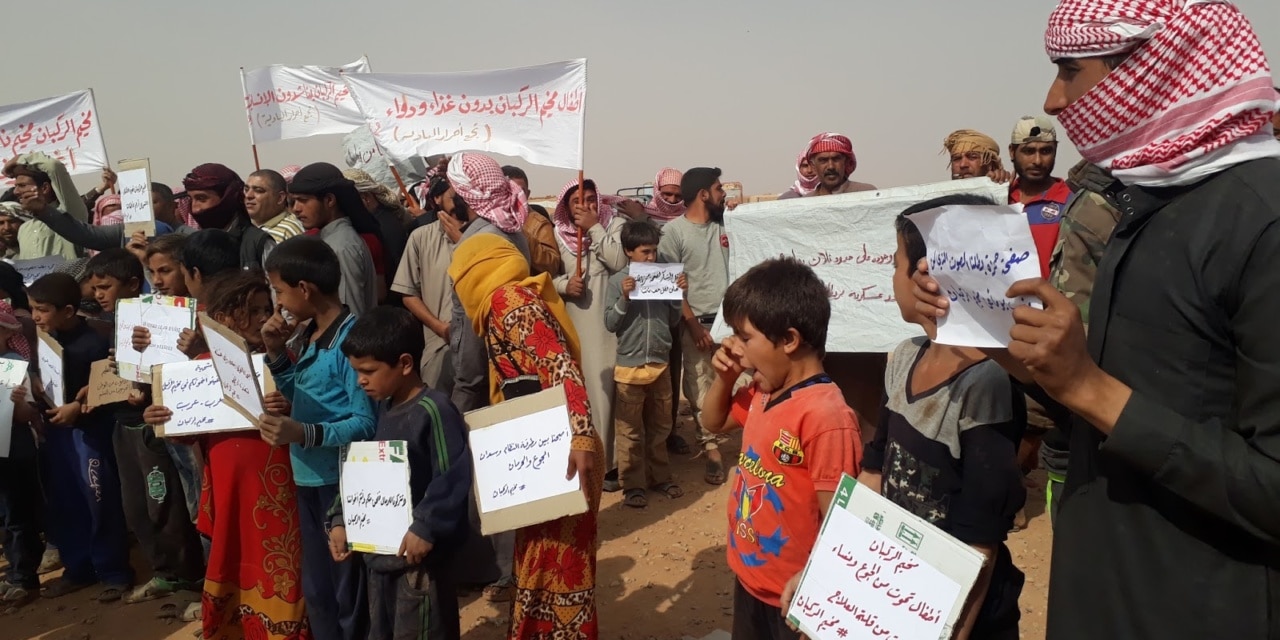Residents of the Rukban camp protest conditions, southeast Syria, October 10, 2018 (Omar a-Shawi)
LATEST
FRIDAY FEATURE
EA on talkRADIO: Why US May Not Withdraw from A Partitioned Syria
EA on talkRADIO: Brexit Meltdown Resumes; Trump Shutdown; Syria Breakdown
Displaced Syrians in the Rukban camp, near the Jordanian border, have appealed for a move to opposition-held northern Syria.
About 50,000 people have been in the barren Rukban area since late 2015, when they fled their homes amid attacks by the Islamic State. They have faced shortages of food, medicine, and supplies for months, the effect of both an Assad regime cut-off and Jordan’s blocking of the border.
Now the residents fear an attack by pro-Assad forces after Donald Trump announced the withdrawal of all 2,000 US military personnel from Syria. Rukban is within a 55-km (34-mile) exclusion zone around the US base at Tanf, near the Iraqi and Jordanian borders.
“Trump’s Withdrawal Leaves 50,000 in Syria’s Rukban Camp to Die”
Open Letter to UK Prime Minister: Help 50,000 Displaced in Rukban Camp
The camp’s management have written to leaders such as Trump, French President Emmanuel Macron, and UK Prime Minister Theresa May:
We are calling for the international protection of residents inside the camp. After the US announced its decision [to leave Syria], we urge you to relocate us to northern Syria.
We need the international community to find an appropriate solution so that people are guaranteed peace, dignity and security.
The UN has warned that thousands of displaced, including children, are at risk after the Assad regime cut the main route into the camp, used by Bedouin traders to bring in food and essential goods, and barred aid. Medics have spoken of the threat from the lack of adequate facilities and medicines, with tens of deaths this autumn blamed on the blockade. Water pollution, unsafe human waste disposal, and garbage accumulation have led to diarrhea, acute respiratory infections, and other illnesses.
Jordan closed its border in June 2016 after an Islamic State suicide bombing killed several of its personnel.
The Assad regime has allowed only one UN aid convoy, in November, since last January.
The letter from management summarized:
Hunger, disease, and abuse are on the rise, so we are asking the United Nations and humanitarian bodies to provide immediate and continuous aid and medical supplies to the camp.
We have no source of livelihood. In 2018 the camp had only received one aid shipment, and it’s not enough to last a family for more than one week or two weeks at best.
The Assad regime has tried to force the displaced to return to their home areas, but residents say they fear detentions, forced conscription, and loss of their property if they go back.
“These towns and cities are occupied by [pro-Assad] Shiite terrorist militias. How can we trust the guarantees from the government that it’s safe to return?” said camp resident Jamil Abu Ahmed.
Russian Airstrikes on Idlib Province
Breaking the demilitarized zone which it agreed with Turkey in September, Russian warplanes attacked towns in Idlib Province in northwest Syria on Thursday.
The attacks were on villages west of Khan Sheikhoun, the site of an Assad regime sarin attack in April 2017 which killed about 90 people and wounded hundreds.
Rescuers dug victims, including a family of seven, out of rubble.
إنقاذ عائلة كاملة مؤلفة من 7 أشخاص من بينهم طفل وامرأتان من قبل فرق الدفاع المدني، كانوا عالقين تحت أنقاض منزلهم الذي تعرض لغارة جوية من قبل الطيران الحربي فجر اليوم في مزرعة المنطار غرب مدينة #خان_شيخون.#الخوذ_البيضاء #إدلب #سوريا pic.twitter.com/6Rbn2uUJ8B
— الدفاع المدني السوري (@SyriaCivilDefe) January 4, 2019
A video showing civilians being pulled out of rubble at #al_Mentar farm west of the town of #Khan_shikhun Prev #Idlib after being targeted by a Russian air strike#Syria #Idlib #EyesOnIdlibhttps://t.co/6PpjjqdWv4 pic.twitter.com/mqPl3USu32
— FARED (@FARED60350386) January 4, 2019
Since its agreement with Turkey, which suspended a Russian-regime offensive to regain Idlib, Russia had carried out only sporadic airstrikes on the periphery of the 15 to 20-km wide and 100-km long demilitarized zone.
Islamist Factions Fighting in Northwest
Islamist factions have been clashing for several days in opposition-held Idlib and western Aleppo Provinces in northwest Syria.
The fighting began earlier this week after the jihadist bloc Hay’at Tahrir al-Sham blamed the Nour ed-Din al-Zinki faction — part of the Turkish-supported rebel National Liberation Front — for an ambush which killed five HTS members. On Tuesday, HTS attacked Zinki-held towns in western Aleppo.
HTS has taken control of several towns and villages, including Daret Izza. Observers said it is seeking a contiguous belt of territory from north of Idlib city, near the Turkish border, to the Aleppo countryside.
The jihadist bloc took control of part of Idlib Province in 2017 when it defeated the rebel faction Ahrar al-Sham.
The National Liberation Front has counter-attacked in Idlib and issued a statement:
We hold Tahrir al-Sham responsible for the dangerous and catastrophic repercussions that result from its escalation and call on its wise men to stop the fighting and preserve what is left of the revolution.
However, the NLF has had little apparent effect so far, and Turkey — which entered northwest Syria in August 2016 — has not intervened.
Instead, some analysts are writing this morning of an HTS effort for “reconciliation” agreements — a tactic used by the Assad regime — to take over more towns and villages. The deals promise the areas no fighting and no harm to al-Zinki members if administration is handed over to the HTS’s “salvation government”.

